Carrots
 The two most lamented problems of carrot growers are slow germination and forking. First carrot seed is small and does not have much stored food reserves. If the germinating seed takes too much time to push through crusted soil or the top half inch of soil dries out repeatedly, they can’t make it.
The two most lamented problems of carrot growers are slow germination and forking. First carrot seed is small and does not have much stored food reserves. If the germinating seed takes too much time to push through crusted soil or the top half inch of soil dries out repeatedly, they can’t make it.
Try some of the recommended planting tips if you have trouble getting carrots to come up or you have clay soil. Try trenching and filling the trench with composted soil mix or compost and sand, or on amended soil, try covering the seed with sifted/compost, sand or vermiculite. Carrots are divided into shape and length. This variation allows you to choose one for your soil condition. Don’t plant long thin carrots if you have heavy soil.
There are several causes for forked carrots - compacted soil, too much water, heavy fertilization (fresh manure), close spacing and disease. The stump-rooted carrots like Chantenay, or short tapered ones like Danvers, are less likely to fork but all carrot varieties fork if the soil is dry, compacted or rocky.
I used to buy carrot seeds in bulk from Charles Ledgerwood, an old time seedsman. He had a seed store in Carlsbad and previously worked for Ferry-Morris Seed Co. for many years. He wrote extensive notes of forking of carrots.
He says that regardless of the variety of carrot you are growing, the shape and length of the mature carrot is determined when the tiny root is the size and diameter of a piece of sewing thread. This fact is true regardless of the type of soil in which the crop is grown or the time of year it is planted.Carrot seeds require soil to be kept wet after planting for up to 12 days or more depending on the temperature. This long period of wet upper soil causes water to penetrate to deeper depths, and small capillary pores in the soil continue to bring this deeper moisture up to the tiny carrot root. When the baby carrot roots need for water is satisfied it stops penetrating the ground, and divides and spreads laterally or “forks”. This “forking” occurs at whatever depth the ground is saturated when the root is the size of sewing thread, or up to string size.
Ledgerwood goes on to say that the shorter varieties such as Chantenay may fork at shallow depths, but the extra long kinds, such as Gold Pak, Long Imperator or Nuggeteer may fork at either shallow or deeper depths at what level the soil is saturated when the root is less than string size
Ledgerwood gives the solution: Stop watering carrots when the tops are about ½ to ¾ inches tall and the roots are only thread size. They have a remarkable ability to do without water at this stage, but must be watched closely to know when they reach their extremity and need to be irrigated again. Because carrots planted in the summer or early fall need an abundance of water, it is a time when forking is most likely to occur. But, it still is true that water must be withheld from the tiny little carrot plants in order to force them to penetrate the ground to full depth. After they show a slight wilting, normal watering can be resumed, and no amount of over watering will affect the shape of the mature carrot after the tiny root has reached its full depth. Irrigation in any amount should not be allowed when the crop is in the thread stage - but all water should be withheld until the tops begin to “look thirsty.” A sampling of the tiny roots might also be advisable at various places in the field, to see how the roots are developing in the thread size stage. Rains, however, during the thread stage of growth will prevent drying and induce forking.
Testing done by the University of Florida has shown that the ultimate shape of a carrot is determined in the first 21 days of growth. The carrot taproot is thread-like and if the temperature of the soil is above 82 degrees F. at a 6 inch depth or if the soil is saturated with water for as little as 12 hours during the first seven days after germination, there will be an increase in forking and the taproot will not grow as long. Don’t plant if soil temperature is over 80 degrees at a 2-4 inch depth.
Before planting be sure soil is moist, after seeding and covering not more than ½ inch, mist the covering on a daily basis to keep it from drying out until seeds begin to germinate. Do not over water. Wooly aphid, with their ant association, can be a problem on carrots in the winter. They feed at the crown and just below ground level. Get rid of the ants or you can’t control the aphid.
Also check out ...
http://vric.ucdavis.edu/veg_info_crop/carrots.htm
http://www.ipm.ucdavis.edu/PMG/selectnewpest.carrots.html
Planting Dates
Coastal:
Seeds can be planted from September to April.
Inland:
Seeds can be planted from September to March.
Varieties
It is difficult to recommend varieties except for the current year. Ones listed here are old favorites and may not be available now from source listed.
Varieties: Stokes Catalog lists 26 varieties from baby carrots to hybrids and open pollinated old standbys. The Burpee seed catalog has a variety chart with eight different lengths from less than 4 inches to over 8 inches long. Sunset Magazine (9/86) listed 3 new imported varieties of sweet hybrids. They are Toudo (Burpee), Mokum (Thompson & Morgan), Lindoro (Park) and Minicor (Stokes). Baby carrots are hybrid varieties that mature early (49 - 54 days)

